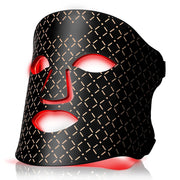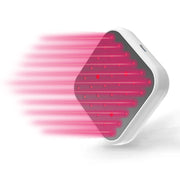If you’re someone who experiences pain and loss of mobility due to arthritis, you know how frustrating the disease can be. According to the Centers for Disease Control and Prevention (CDC), 54 million Americans suffer from arthritis, and 60 percent are under the age of 65. Of those, an estimated 8 million people find it difficult or even impossible to work because of their disease.
With so many Americans affected by this debilitating disease, it’s more important than ever to find a solution that is effective and safe. Numerous studies have shown that red light therapy for arthritis shows promise as one such treatment. This article explores what red light therapy is, how it works, and how it can help ease the pain and suffering in knees, hands, and other arthritic joints.
Red and Near-Infrared Light Therapy for Arthritis: A Safe, Natural Alternative
Red light therapy has roots in solar therapy, which is the practice of using sunlight to heal. For centuries, healers have recommended exposure to the sun to treat a variety of ailments, from sleep disorders to skin rashes.
More recently, scientists have isolated the effects of specific wavelengths of invisible and visible light on the human body. In terms of arthritis pain, red light therapy has shown to be the most effective.

The Most Beneficial Wavelengths
The term “red light therapy” refers to a treatment in which devices fitted with light-emitting diode (LED) bulbs bathe the body in red light and/or near-infrared (NIR) light. Specifically, this involves red light with wavelengths between 630 and 660 nanometers (nm); and NIR light with wavelengths between 810 and 850nm.
This range of wavelengths is known as the “therapeutic window,” in which there are beneficial changes in cellular activity and a positive ripple effect of biological activity in the body – including pain relief from arthritis – with no side effects.
These wavelengths are part of the light spectrum of natural sunlight; but unlike sunlight, which contains potentially harmful ultraviolet waves, red/NIR light will not cause burns or harm the body.
Red light therapy is also known as low-level light therapy (LLLT) or photobiomodulation. In many studies, you’ll also see the term “low-level laser therapy,” which is the same concept – the application of red or NIR light – but rather than LED bulbs, low-level laser light uses “cold lasers,” meaning lasers that don’t generate a lot of heat.
The difference is simply that lasers concentrate the light more than LEDs; for therapeutic purposes, however, it’s not necessary to be as precise as with lasers used for surgery. The key is to deliver light photons as deeply into the tissues as possible, and both lasers and LED devices do this very effectively.
Modern red light therapy and its natural healing ability are well-documented, particularly concerning its effects on arthritis. Unlike pain relief medication that temporarily numbs the pain but doesn’t address the cause of the pain, red light therapy works at the cellular level where the light stimulates reduced inflammation, pain relief, and the potential for healthy cartilage regrowth.
Many factors are involved with red light therapy’s ability to promote healing. One of the most important is its effect on tiny energy-producing organelles, known as mitochondria, that are found inside most cells of the body.
Red Light Therapy Stimulates Mitochondrial Energy
As red and NIR light penetrates the skin, the light photons excite light-sensitive chromophores inside mitochondria. This stimulates the production of a high-energy molecule called adenosine triphosphate (ATP), which is the cells’ primary fuel. More cellular energy equals better performance including the ability of cells to replicate and repair themselves.
When you’re tired or hungry, you can’t perform at your best. If this state becomes chronic you become more vulnerable to infection and you struggle with even the most basic things. And when you’re not feeling well, pain perception is amplified.
On a much smaller scale, it’s the same with your cells – depleted cells cannot operate at their best. So, boosting cellular energy is key to treating the underlying condition(s) that can have a ripple effect of offering pain relief while also slowing or stopping the progression of the disease.
What this means for you: The cells that produce cartilage worn down by overuse or damaged by injury or other causes could start to regrow. Pain relief is one effect of newly regrown cartilage, as the cartilage cushions the bones and allows for pain-free movement.
Red Light Therapy Supports Hormesis (Stimulated Healing)
The term “hormesis” refers to a phenomenon in which a harmful substance can have stimulating and beneficial effects on the body as long as the quantity of the harmful substance is small. An example of this is exercise, which causes microscopic tears in muscle fibers. As the body heals these muscle tears, the muscles become stronger and larger.
On a cellular level, exercise leads to a temporary increase in free radicals, which are unstable molecules that in large quantities cause damage to proteins, cells, and DNA. Yet in response to a temporary spike in free radicals, the body adapts quickly with anti-inflammatory effects such as increased blood circulation and increased mitochondrial activity.
Red light therapy activates many of the same cell-level responses as exercise – and in the process, it stimulates the body to repair itself.

Red Light Therapy Can Reduce Inflammation
Acute inflammation is an immune system response and part of the natural healing process. When inflammation becomes chronic, however, it causes delays in healing and can lead to autoimmune disorders such as rheumatoid arthritis. Chronic inflammation must be reduced in order to promote healing.
Reducing inflammation is absolutely essential in treating arthritis, especially rheumatoid and psoriatic arthritis, both of which are inflammatory disorders.
Many studies have revealed red light therapy’s anti-inflammatory effects. One major review was conducted in 2019 by researchers from Poland, who state: “A wide range of immune cell studies have demonstrated that exposure to [red/near-infrared light] most often has an anti-inflammatory effect.”
In the case of arthritis, it’s especially important to use deep-penetrating NIR light therapy to target inflammation in the joints and relieve joint pain.
Red Light Therapy Improve Collagen Production
Collagen is the body’s main structural protein. Because it provides the skin with a structure that results in a firm, full appearance, collagen is most often associated with the skin. But it is also an important component in muscles and connective tissue, including cartilage, which is the main type of connective tissue in the body’s joints.
The principal function of cartilage is to connect bones and provide a smooth, lubricated surface that allows joints to bend. Without this cartilage, you’re likely to experience mild to severe joint pain anytime you bend a joint.
Cartilage also cushions joints so they can carry the weight of the body without damage to the bones. Collagen makes up about 60 percent of cartilage, so increasing collagen production can help heal damage to the cartilage in knees and other joints.
Osteoarthritis is a degenerative disease often caused by repetitive motions that gradually wear down the cartilage in joints. While it was once thought that cartilage could not be regenerated, several studies have confirmed that it can, using red light therapy.
One of these studies was conducted in 2019 by a team of Brazilian researchers, who found that exposure to red and NIR light is an effective way to stimulate collagen production in the joints. The study revealed that red light therapy promoted cartilage recovery and reduced the progression of cartilage degradation, which suggests a potential role for red light in treating chronic osteoarthritis.
During a 2017 study, researchers from Saudi Arabia found that red light helps increase the regeneration and thickness of cartilage and reduce osteoarthritis pain. Patients with knee osteoarthritis were treated with low-level laser therapy three days per week for four weeks. Results were also measured eight weeks after treatment. Researchers found significant differences in pain relief and improved cartilage thickness.
A 2013 clinical trial revealed that red light successfully treated tears in the meniscus, which is cartilage in the front of the knee joint. Four weeks after receiving red light therapy, the treatment group reported a statistically significant decrease of symptoms compared to the placebo group. The researchers suggest red light therapy is a valid consideration for patients with meniscal tears who do not wish to undergo surgery.
This is great news for anyone who’s looking into red light therapy for knee pain or joint pain or is exploring red light therapy arthritis treatments in general.
Red Light Therapy Helps Relieve Pain
For arthritis sufferers, pain relief is one of the more surprising – and welcome – benefits of red light therapy.
Unlike pain-killing medications, red light therapy doesn’t block your perception of pain. Rather, it works at the cellular level to promote cellular health and reduce inflammation, which then reduces pain signals at the source.
Red/NIR light therapy activates stem cell production in the bone marrow to support the healing process. Stem cells are non-specialized cells that are present in an inactive state throughout the body. When they are needed, like in the event of an injury, infection, or cell damage from inflammation, stem cells are transported via the bloodstream to the affected area. There they develop into any cell that’s needed.
This article provides a more in-depth look at red light therapy for pain relief.
Red Light Therapy Increases Blood Flow
Although cartilage doesn’t contain blood vessels, stimulating blood flow to the area means that the surrounding tissues can receive the nutrients they need. This is important because muscle pain can affect your posture and gait, therefore contributing to poor joint biomechanics that could aggravate arthritis pain.
Boosting the blood flow and lymph flow supports proper soft tissue health, including the muscles that support proper joint alignment. According to a 2017 study by Austrian researchers, red light promotes the proliferation of endothelial cells. These are the cells that make up capillaries, which are tiny blood vessels in both the cardiovascular and lymphatic systems.
What Kind of Red Light Therapy Is Best for Arthritis?
We’ve been discussing the benefits of red light therapy, meaning both red and NIR wavelengths. Does red light therapy work better, or is NIR light therapy more effective for pain relief and slowing the progression of arthritis?
Red light absorbs into the skin to a depth of about 4mm, or .16 inch, which is nearly the thickness of the skin. Thus, red light’s ability to absorb into the deeper layers of skin means that it’s ideal for treating “skin deep” conditions.
NIR wavelengths are longer so they penetrate deeper, to a depth of about 5mm, or slightly over 3/16 of an inch. This means cartilage in your knee, hand, foot, and elbow – the areas where arthritis is most prevalent – can receive the healing benefits of light.
In the case of arthritis, NIR light therapy becomes particularly important. The deeper penetration of NIR wavelengths means they could stimulate cellular health and offer pain relief much deeper in the body than is possible with red wavelengths alone.
Use red light along with NIR light to positively affect cartilage that is close to the skin such as in the knuckles and to receive bonus benefits, such as treating the signs of aging.

Wavelengths That Are Not Ideal for Arthritis Treatment
Because of their short wavelengths, most colors in the visible light rainbow are not ideal as a therapy for pain and other symptoms of arthritis.
- Blue wavelengths (450–500nm) penetrate the skin to 1mm deep. Blue wavelengths can be effective for treating acne and precancerous lesions, but may also be damaging to the skin and potentially contribute to macular degeneration. So, we recommend caution when using blue light.
- Green wavelengths (500–570nm) penetrate to 2mm. Aside from migraine pain and easing the redness of the skin, there is little scientific evidence to suggest green wavelengths have many beneficial effects on the body.
- Yellow/Amber wavelengths (570–620nm) penetrate to 3mm. Few studies have been done on these wavelengths, but some research suggests that yellow/amber light may play a role in boosting moods and soothing redness in the skin.
When it comes to ultraviolet and far-infrared light, the news is not great for arthritis sufferers:
UV wavelengths (380–450nm) only penetrate the epidermis to 0.1mm.
Due to its skin-damaging properties, UV therapy must be administered with extreme caution and only by a medical professional.
Sun exposure has been said to help relieve arthritic pain, especially from psoriatic arthritis. This is likely due to the deeper-penetrating red and infrared wavelengths. Sunshine is also a mood-booster, which can help decrease the perception of pain.
As mentioned previously, however, sunlight contains UV wavelengths of light that are harmful and have been linked to skin cancer and other serious ailments. Sun exposure, therefore, must be limited and carefully monitored; how much is too much depends on the individual.
Far-infrared light (over 1,000nm) is not perceived by the body as light.
Rather, far-infrared wavelengths are perceived as heat. Infrared saunas are popular ways to enhance health, reduce inflammation, speed up the wound healing process, and relieve pain.
Yet if an infrared sauna emits far-infrared light, which causes the water in the body to heat up, thermal (heat) injuries can happen to the eyes and internally, even without pain. Therefore, infrared light therapy should be used with caution. Pregnant women and anyone with heart disease are cautioned not to use infrared light therapy.
The takeaway is that light wavelengths shorter than red are simply too short to reach the cartilage, which makes them irrelevant to arthritis treatment; and far-infrared light, while potentially beneficial for arthritis, carries risk and should be used cautiously.
Scientific Studies on Red Light Therapy for Specific Types of Arthritis
Most people who suffer from arthritis have osteoarthritis (OA). A smaller percentage have rheumatoid arthritis (RA), and an even smaller percentage have psoriatic arthritis (PA), an inflammatory type of arthritis that affects some people with the chronic skin disorder known as psoriasis.
Studies on Red Light Therapy for OA Knee Pain Relief
Most people who suffer from OA experience knee pain, which can severely diminish their quality of life. This is especially true for elderly patients who may already have balance and mobility issues. In anyone with OA, knee pain can prevent normal activities and make even the act of sitting down or standing up painful and difficult. Thus, knee pain relief is a top concern for most OA sufferers.
Read more about the effects of red and near-infrared light therapy on knee pain. It’s important to know that it’s not always a function of age, as OA can also affect young, fit, active people and even elite athletes.
Following is a discussion of several studies that are relevant to anyone who suffers from OA and is seeking relief from OA-related knee pain.
Since the most severe cases of OA may require a complete knee replacement, the findings of a 2015 study by Hong Kong researcher David Ip are encouraging. The study found that adding red light therapy to conventional physical therapy for treating knee arthritis can successfully postpone the need for joint replacement surgery.
Participants in a 2012 study who received red light therapy in conjunction with exercise showed an increased range of motion. Forty middle-aged/elderly participants with knee OA were randomized into one of two groups: the treatment group and the placebo group. Both groups were asked to exercise. Those in the red light therapy treatment group reported significant pain relief and improvement in joint functionality.
A 2016 study on 72 patients with knee OA showed that after just seven days of treatment with red light therapy, patients reported significant pain relief.
A 2015 study revealed short-term benefits in pain relief and increased joint mobility among men and women with OA pain whose knees were irradiated with NIR light three times a week for a total of three weeks (nine sessions).
Sixty-seven male patients with knee OA participated in a 2017 study by researchers from Saudi Arabia. Those who were treated with red light therapy had increased thickness of synovial and femoral cartilage.
In a 2018 clinical trial, a combination of red light therapy and ultrasound therapy reduced knee pain and improved physical functionality after three months. Forty-two women with knee OA participated in the study, which revealed that the combination of red light therapy and ultrasound significantly reduced pain and increased physical functionality after three months of treatment.
Fans of alternative medicine will be happy to know that a 2014 study found that short-term application of red light therapy to specific acupuncture points in conjunction with exercise and advice effectively reduced pain and improved the quality of life in patients with knee OA.
While red light therapy should not be considered a cure for OA or any other type of disorder, it shows great promise as a treatment that can increase the thickness of knee cartilage, reduce chronic inflammation, and offer pain relief.
How Red Light Therapy Can Restore Movement Throughout the Body for Osteoarthritis Sufferers
Loss of function, swelling, deformity, and pain can affect any joints, including the wrists and fingers. It can even affect joints in the neck, jaw, shoulders, and back, which significantly impacts an individual’s life.
Following are some important studies on the effects of red and infrared light on OA elsewhere in the body (not located in the knees).
A 2016 study found red light therapy to be a safe and effective treatment that reduced pain and swelling and increased joint mobility in patients afflicted with Heberden’s and Bouchard’s osteoarthritis, a type of arthritis that causes severe swelling and deformity of joints. After five to seven treatments, the patients’ pain decreased, as did their ring sizes, and they experienced an increased range of motion.
A 2013 paper on osteoarthritis by world-renowned red light therapy expert Michael Hamblin states that a single application of red light therapy led to significant reductions in inflammatory cytokines 24 hours after treatment. Cytokines are proteins released by cells that are involved in the body’s communication of pain signals; thus, reducing inflammatory cytokines could lead to a lessened perception of pain.
In a 2013 study, a team of Canadian researchers found that red light therapy was effective in reducing pain and improving function in acute radiculopathy (pinched nerve), cervical osteoarthritis, and acute neck pain.
A 2009 meta-analysis of numerous studies revealed that red light therapy reduced acute neck pain immediately after treatment. In chronic neck pain, the relief lasted up to 22 weeks after treatment was completed.
A 2016 animal study found that red light therapy could enhance tissue repair in the temporomandibular joints, which are the two joints connecting the jawbone to the skull.
During a 2009 study at a university in Sparta, Greece, red light therapy was found to relieve musculoskeletal pain in an inflammatory condition called frozen shoulder.
In a 2006 study, NIR and far-infrared wavelengths (800-1200nm) were used successfully as a treatment for low back pain that was unrelated to arthritis. This suggests that the deeper penetration of NIR light therapy (810, 830, and 850nm) may be effective in treating back pain due to osteoarthritis.
In a 2016 study, the combination of red light therapy and stretching decreased pain in patients with ankylosing spondylitis. This is a disease that can cause vertebrae to fuse, making the spine less flexible and contributing to a hunched-forward posture. Although not directly related to arthritis, it is an inflammatory disease that may be helped with NIR light therapy.
How Red Light Therapy Can Soothe Inflammation and Reduce Rheumatoid Arthritis Pain
The treatment of RA is complex and ongoing since the root cause of the inflammatory disorder must be addressed for symptoms to go into remission.
Although there are few studies specific to red light therapy and RA, the promising results with OA – specifically the reduction of inflammation – suggest that red light may potentially offer relief from RA and other inflammatory disorders.
A 2013 animal study revealed that red light therapy can reduce the inflammatory response in early and late progression stages of RA.
A 2000 controlled trial found that red light therapy reduced RA pain by 70 percent compared with the placebo group. Patients also saw a significant decrease in morning stiffness and increases in palm flexibility.
A 2014 study found that red light therapy reduced the presence of IL-20, an important inflammatory cytokine, which suggests that infrared light therapy could be useful for RA therapy.
Although more studies are needed to confirm the effectiveness of red light therapy in treating RA, these studies, along with the more numerous OA studies, show great promise.
How Red Light Therapy Can Treat the Skin and Underlying Tissues in Psoriatic Arthritis
Psoriatic arthritis is a chronic inflammatory disorder that sometimes develops in people with psoriasis. Symptoms of PA include joint pain, morning stiffness, and swelling.
A 2017 study on the effects of red light therapy on psoriasis stated that near-infrared light treatment shows promise for treating psoriasis “due to its strong penetration and beneficial photobiomodulation” (the effect of NIR light therapy on human cells).
While the study was concerned with treatment of this chronic skin disorder and not resulting arthritis, the deep penetration of NIR light therapy – and its efficacy in treating inflammation deeper in the body – suggests that it could be a viable treatment for psoriatic arthritis.










